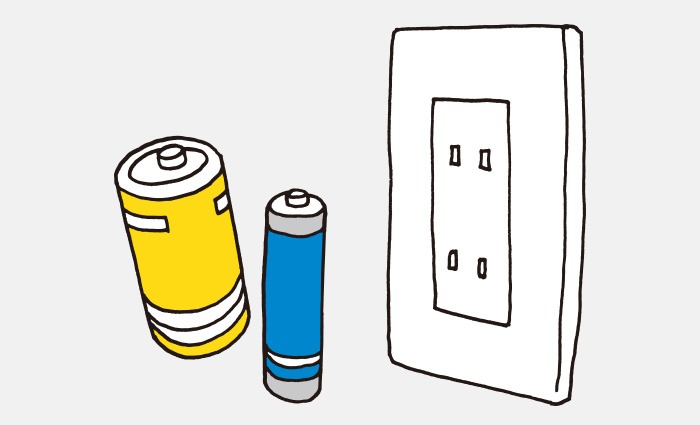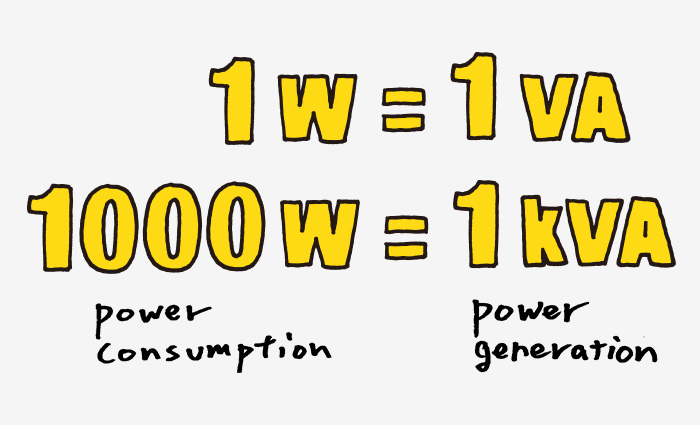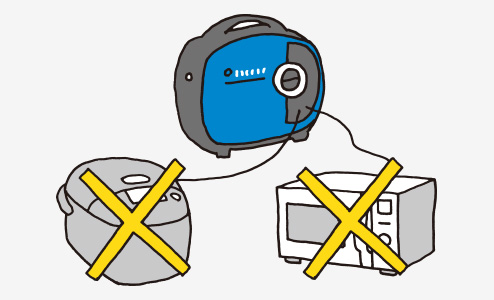Basic information about the generator
This glossary of terms is related to electricity and power generators.
This is a Q & A related to generators
- How is power generated?
- What is the difference between “direct current” and “alternating current?
- What is the meaning of “voltage (V, volt),” “current (A, ampere),” and “power (W, watt)?”
- What is the difference between W (watt) and VA (“V–A”)?
- What happens to electrical equipment if an inappropriate generator is selected?
- Glossary items one may want to know
Q1 : How is power generated?
A : A power-generating body is rotated by an engine to generate electricity
It is not unlike the experiment in science class where electricity was generated with a coil and a magnet. In fact, by moving a magnet in the vicinity of a coil, electricity is generated due a phenomenon called "electromagnetic induction." Basically, this process also occurs in the case of a generator. Based on this principle, by using an engine to rotate a component called a power-generating body, an alternating current is produced.

Q2 : What is the difference between “direct current” and “alternating current?”
A : The flow of electricity differs
There are two types of electric current: direct current and alternating current. In the case of a direct current, the voltage is normally constant, but an alternating current is characterized by change in voltage over time. Direct current is storable and can be used in dry cells and batteries, whereas alternating current is transformable and offers excellent versatility for use in powering household appliances.

Q3 : What is the meaning of “voltage (V, volt),” “current (A, ampere),” and “power (W, watt)?”
A : Important elements that constitute electricity
Electricity is often likened to the flow of water. Imagine a flowing river. The larger the difference between the upstream and downstream heights of the river, the greater the momentum of the water; and the wider the river, the higher the amount of water flowing into the basin. In this respect, the “voltage” (V, volts) corresponds to the difference in height and the “current” (A, amperes) corresponds to the width of the river. Since the “power” (W, watts) is the work rate per unit of time, it can be conceived as the amount of water that has moved from upstream to downstream in a given time. This power can be determined by multiplying the voltage and current.

Q4 : What is the difference between W (watt) and VA (“V–A”)?
A : The difference between power consumption and power output
W (watts): the power consumed by the equipment used (power consumption)
VA (“V–A”): electric power output from the generator (power generation)

Q5 : What happens to electrical equipment if an inappropriate generator is selected?
A : Use becomes impossible
If the power consumption is higher than the rated output of the generator, the power supply will stop automatically owing to overload. Therefore, the use of electric equipment becomes impossible.

Glossary items one may want to know
Inverter
Apparatus for converting direct current to alternating current. In an inverter generator, after temporarily converting an alternating current to direct current, the inverter reconverts it back to alternating current.
Open-type/soundproof type
A generator of the type in which the engine, which is the source of noise, is provided with a cover and is known as a soundproof-type generator, whereas the uncovered type is called an open-type generator.
Parallel running
The two models, “EF2000iS” and “EF2400iS,” can be operated in parallel running by connecting two identical models in parallel using a dedicated cord to increase the output. This offers the benefit that in accordance with the amount of output required, one or two units can be used selectively.